жӮЁеҘҪпјҢзҷ»еҪ•еҗҺжүҚиғҪдёӢи®ўеҚ•е“ҰпјҒ
иҝҷзҜҮвҖңKotlinеҚҸзЁӢдёҠдёӢж–ҮдёҺдёҠдёӢж–Үе…ғзҙ е®һдҫӢеҲҶжһҗвҖқж–Үз« зҡ„зҹҘиҜҶзӮ№еӨ§йғЁеҲҶдәәйғҪдёҚеӨӘзҗҶи§ЈпјҢжүҖд»Ҙе°Ҹзј–з»ҷеӨ§е®¶жҖ»з»“дәҶд»ҘдёӢеҶ…е®№пјҢеҶ…е®№иҜҰз»ҶпјҢжӯҘйӘӨжё…жҷ°пјҢе…·жңүдёҖе®ҡзҡ„еҖҹйүҙд»·еҖјпјҢеёҢжңӣеӨ§е®¶йҳ…иҜ»е®ҢиҝҷзҜҮж–Үз« иғҪжңүжүҖ收иҺ·пјҢдёӢйқўжҲ‘们дёҖиө·жқҘзңӢзңӢиҝҷзҜҮвҖңKotlinеҚҸзЁӢдёҠдёӢж–ҮдёҺдёҠдёӢж–Үе…ғзҙ е®һдҫӢеҲҶжһҗвҖқж–Үз« еҗ§гҖӮ
EmptyCoroutineContextд»ЈиЎЁз©әдёҠдёӢж–ҮпјҢз”ұдәҺиҮӘиә«дёәз©әпјҢеӣ жӯӨgetж–№жі•зҡ„иҝ”еӣһеҖјжҳҜз©әзҡ„пјҢfoldж–№жі•зӣҙжҺҘиҝ”еӣһдј е…Ҙзҡ„еҲқе§ӢеҖјпјҢplusж–№жі•д№ҹжҳҜзӣҙжҺҘиҝ”еӣһдј е…Ҙзҡ„contextпјҢminusKeyж–№жі•иҝ”еӣһиҮӘиә«пјҢд»Јз ҒеҰӮдёӢпјҡ
public object EmptyCoroutineContext : CoroutineContext, Serializable {
private const val serialVersionUID: Long = 0
private fun readResolve(): Any = EmptyCoroutineContext
public override fun <E : Element> get(key: Key<E>): E? = null
public override fun <R> fold(initial: R, operation: (R, Element) -> R): R = initial
public override fun plus(context: CoroutineContext): CoroutineContext = context
public override fun minusKey(key: Key<*>): CoroutineContext = this
public override fun hashCode(): Int = 0
public override fun toString(): String = "EmptyCoroutineContext"
}CombinedContextжҳҜз»„еҗҲдёҠдёӢж–ҮпјҢжҳҜеӯҳеӮЁElementзҡ„йҮҚиҰҒзҡ„ж•°жҚ®з»“жһ„гҖӮеҶ…йғЁеӯҳеӮЁзҡ„з»„з»Үз»“жһ„еҰӮдёӢеӣҫжүҖзӨәпјҡ
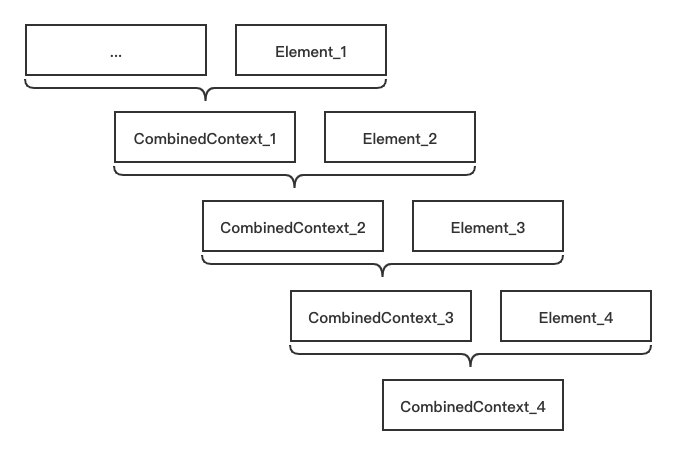
еҸҜд»ҘзңӢеҮәCombinedContextжҳҜдёҖз§Қе·ҰеҒҸ(д»Һе·Ұеҗ‘еҸіи®Ўз®—)зҡ„еҲ—иЎЁпјҢиҝҷд№Ҳи®ҫи®Ўзҡ„зӣ®зҡ„жҳҜдёәдәҶи®©CoroutineContextдёӯзҡ„plusж–№жі•е·ҘдҪңиө·жқҘжӣҙеҠ иҮӘ然гҖӮ
з”ұдәҺйҮҮз”Ёиҝҷз§Қж•°жҚ®з»“жһ„пјҢCombinedContextзұ»дёӯзҡ„еҫҲеӨҡж–№жі•йғҪжҳҜйҖҡиҝҮеҫӘзҺҜе®һзҺ°зҡ„пјҢд»Јз ҒеҰӮдёӢпјҡ
internal class CombinedContext(
// ж•°жҚ®з»“жһ„е·Ұиҫ№еҸҜиғҪдёәдёҖдёӘElementеҜ№иұЎжҲ–иҖ…иҝҳжҳҜдёҖдёӘCombinedContextеҜ№иұЎ
private val left: CoroutineContext,
// ж•°жҚ®з»“жһ„еҸіиҫ№еҸӘиғҪдёәдёҖдёӘElementеҜ№иұЎ
private val element: Element
) : CoroutineContext, Serializable {
override fun <E : Element> get(key: Key<E>): E? {
var cur = this
while (true) {
// иҝӣиЎҢgetж“ҚдҪңпјҢеҰӮжһңеҪ“еүҚCombinedContextеҜ№иұЎдёӯеӯҳеңЁпјҢеҲҷиҝ”еӣһ
cur.element[key]?.let { return it }
// иҺ·еҸ–е·Ұиҫ№зҡ„дёҠдёӢж–ҮеҜ№иұЎ
val next = cur.left
// еҰӮжһңжҳҜCombinedContextеҜ№иұЎ
if (next is CombinedContext) {
// иөӢеҖјпјҢ继з»ӯеҫӘзҺҜ
cur = next
} else { // еҰӮжһңдёҚжҳҜCombinedContextеҜ№иұЎ
// иҝӣиЎҢgetж“ҚдҪңпјҢиҝ”еӣһ
return next[key]
}
}
}
// ж•°жҚ®з»“жһ„е·ҰеҸіеҲҶејҖж“ҚдҪңпјҢд»Һе·ҰеҲ°еҸіиҝӣиЎҢfoldиҝҗз®—
public override fun <R> fold(initial: R, operation: (R, Element) -> R): R =
operation(left.fold(initial, operation), element)
public override fun minusKey(key: Key<*>): CoroutineContext {
// еҰӮжһңеҸіиҫ№жҳҜжҢҮе®ҡзҡ„ElementеҜ№иұЎпјҢеҲҷиҝ”еӣһе·Ұиҫ№
element[key]?.let { return left }
// и°ғз”Ёе·Ұиҫ№зҡ„minusKeyж–№жі•
val newLeft = left.minusKey(key)
return when {
// иҝҷз§Қжғ…еҶөпјҢиҜҙжҳҺе·Ұиҫ№йғЁеҲҶе·Із»ҸжҳҜеҺ»жҺүжҢҮе®ҡзҡ„ElementеҜ№иұЎзҡ„пјҢеҸіиҫ№д№ҹжҳҜеҰӮжӯӨпјҢеӣ жӯӨиҝ”еӣһеҪ“еүҚеҜ№иұЎпјҢдёҚйңҖиҰҒеңЁиҝӣиЎҢеҢ…иЈ№
newLeft === left -> this
// иҝҷз§Қжғ…еҶөпјҢиҜҙжҳҺе·Ұиҫ№йғЁеҲҶеҢ…еҗ«жҢҮе®ҡзҡ„ElementеҜ№иұЎпјҢеӣ жӯӨиҝ”еӣһеҸӘеҸіиҫ№
newLeft === EmptyCoroutineContext -> element
// иҝҷз§Қжғ…еҶөпјҢиҝ”еӣһзҡ„е·Ұиҫ№йғЁеҲҶжҳҜж–°зҡ„пјҢеӣ жӯӨйңҖиҰҒе’ҢеҸіиҫ№йғЁеҲҶдёҖиө·еҢ…иЈ№еҗҺпјҢеҶҚиҝ”еӣһ
else -> CombinedContext(newLeft, element)
}
}
private fun size(): Int {
var cur = this
//е·ҰеҸіеҗ„дёҖдёӘ
var size = 2
while (true) {
cur = cur.left as? CombinedContext ?: return size
size++
}
}
// йҖҡиҝҮgetж–№жі•е®һзҺ°
private fun contains(element: Element): Boolean =
get(element.key) == element
private fun containsAll(context: CombinedContext): Boolean {
var cur = context
// еҫӘзҺҜеұ•ејҖжҜҸдёҖдёӘCombinedContextеҜ№иұЎпјҢжҜҸдёӘCombinedContextеҜ№иұЎдёӯзҡ„ElementеҜ№иұЎйғҪиҰҒеҢ…еҗ«
while (true) {
if (!contains(cur.element)) return false
val next = cur.left
if (next is CombinedContext) {
cur = next
} else {
return contains(next as Element)
}
}
}
...
}KeyжҺҘеҸЈдёҺElementжҺҘеҸЈе®ҡд№үеңЁCoroutineContextжҺҘеҸЈдёӯпјҢд»Јз ҒеҰӮдёӢпјҡ
public interface Key<E : Element>
public interface Element : CoroutineContext {
// дёҖдёӘKeyеҜ№еә”зқҖдёҖдёӘElementеҜ№иұЎ
public val key: Key<*>
// зӣёзӯүеҲҷејәеҲ¶иҪ¬жҚўе№¶иҝ”еӣһпјҢеҗҰеҲҷеҲҷиҝ”еӣһз©ә
public override operator fun <E : Element> get(key: Key<E>): E? =
@Suppress("UNCHECKED_CAST")
if (this.key == key) this as E else null
// иҮӘиә«дёҺеҲқе§ӢеҖјиҝӣиЎҢfoldж“ҚдҪң
public override fun <R> fold(initial: R, operation: (R, Element) -> R): R =
operation(initial, this)
// еҰӮжһңиҰҒеҺ»йҷӨзҡ„жҳҜеҪ“еүҚзҡ„ElementеҜ№иұЎпјҢеҲҷиҝ”еӣһз©әзҡ„дёҠдёӢж–ҮпјҢеҗҰеҲҷиҝ”еӣһиҮӘиә«
public override fun minusKey(key: Key<*>): CoroutineContext =
if (this.key == key) EmptyCoroutineContext else this
}CoroutineContextжҺҘеҸЈе®ҡд№үдәҶеҚҸзЁӢдёҠдёӢж–Үзҡ„еҹәжң¬иЎҢдёәд»ҘеҸҠKeyе’ҢElementжҺҘеҸЈгҖӮеҗҢж—¶пјҢйҮҚиҪҪдәҶ"+"ж“ҚдҪңпјҢзӣёе…ід»Јз ҒеҰӮдёӢпјҡ
public interface CoroutineContext {
public operator fun <E : Element> get(key: Key<E>): E?
public fun <R> fold(initial: R, operation: (R, Element) -> R): R
public operator fun plus(context: CoroutineContext): CoroutineContext =
// еҰӮжһңиҰҒдёҺз©әдёҠдёӢж–ҮзӣёеҠ пјҢеҲҷзӣҙжҺҘдҪҶдјҡеҪ“еүҚеҜ№иұЎпјҢ
if (context === EmptyCoroutineContext) this else
// еҪ“еүҚElementдҪңдёәеҲқе§ӢеҖј
context.fold(this) { acc, element ->
// acc:е·Із»ҸеҠ е®Ңзҡ„CoroutineContextеҜ№иұЎ
// element:еҪ“еүҚиҰҒеҠ зҡ„CoroutineContextеҜ№иұЎ
// иҺ·еҸ–д»ҺaccдёӯеҺ»жҺүelementеҗҺзҡ„дёҠдёӢж–ҮremovedпјҢиҝҷжӯҘжҳҜдёәдәҶзЎ®дҝқж·»еҠ йҮҚеӨҚзҡ„Elementж—¶пјҢ移еҠЁеҲ°жңҖеҸідҫ§
val removed = acc.minusKey(element.key)
// еҺ»йҷӨжҺүelementеҗҺдёәз©әдёҠдёӢж–Ү(иҜҙжҳҺaccдёӯеҸӘжңүдёҖдёӘElementеҜ№иұЎ)пјҢеҲҷиҝ”еӣһelement
if (removed === EmptyCoroutineContext) element else {
// ContinuationInterceptorд»ЈиЎЁжӢҰжҲӘеҷЁпјҢд№ҹжҳҜдёҖдёӘElementеҜ№иұЎ
// дёӢйқўзҡ„ж“ҚдҪңжҳҜдёәдәҶжҠҠжӢҰжҲӘеҷЁз§»еҠЁеҲ°дёҠдёӢж–Үзҡ„жңҖеҸіз«ҜпјҢдёәдәҶж–№дҫҝеҝ«йҖҹиҺ·еҸ–
// д»ҺremovedдёӯиҺ·еҸ–жӢҰжҲӘеҷЁ
val interceptor = removed[ContinuationInterceptor]
// иӢҘдёҠдёӢж–ҮдёӯжІЎжңүжӢҰжҲӘеҷЁпјҢеҲҷиҝӣиЎҢзҙҜеҠ (еҢ…иЈ№жҲҗCombinedContextеҜ№иұЎ)пјҢиҝ”еӣһ
if (interceptor == null) CombinedContext(removed, element) else {
// иӢҘдёҠдёӢж–ҮдёӯжңүжӢҰжҲӘеҷЁ
// иҺ·еҸ–дёҠдёӢж–Үдёӯ移йҷӨеҲ°жҺүжӢҰжҲӘеҷЁеҗҺзҡ„дёҠдёӢж–Үleft
val left = removed.minusKey(ContinuationInterceptor)
// иӢҘ移йҷӨеҲ°жҺүжӢҰжҲӘеҷЁеҗҺзҡ„дёҠдёӢж–Үдёәз©әдёҠдёӢж–ҮпјҢиҜҙжҳҺдёҠдёӢж–ҮleftдёӯеҸӘжңүдёҖдёӘжӢҰжҲӘеҷЁпјҢ
// еҲҷиҝӣиЎҢзҙҜеҠ (еҢ…иЈ№жҲҗCombinedContextеҜ№иұЎ)пјҢиҝ”еӣһ
if (left === EmptyCoroutineContext) CombinedContext(element, interceptor) else
// еҗҰеҲҷпјҢзҺ°еҜ№еҪ“еүҚиҰҒеҠ зҡ„elementе’ҢleftиҝӣиЎҢзҙҜеҠ пјҢ然еҗҺеңЁе’ҢжӢҰжҲӘеҷЁиҝӣиЎҢзҙҜеҠ
CombinedContext(CombinedContext(left, element), interceptor)
}
}
}
public fun minusKey(key: Key<*>): CoroutineContext
... // (Keyе’ҢElementжҺҘеҸЈ)
}1.plusж–№жі•еӣҫи§Ј
еҒҮи®ҫжҲ‘们жңүдёҖдёӘдёҠдёӢж–ҮйЎәеәҸдёәAгҖҒBгҖҒCпјҢзҺ°еңЁиҰҒжҢүйЎәеәҸеҠ дёҠDгҖҒCгҖҒAгҖӮ
1пјүеҲқе§ӢеҖјAгҖҒBгҖҒC
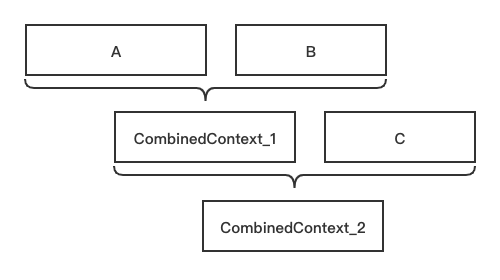
2пјүеҠ дёҠD
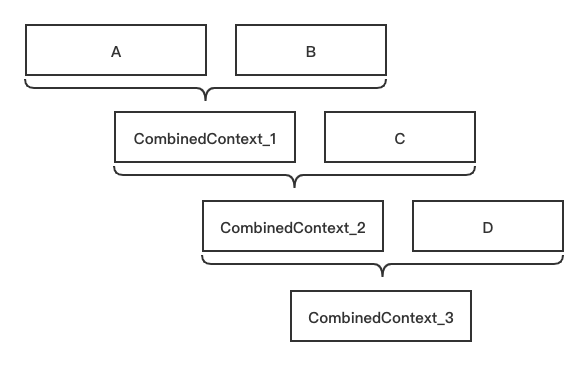
3пјүеҠ дёҠC
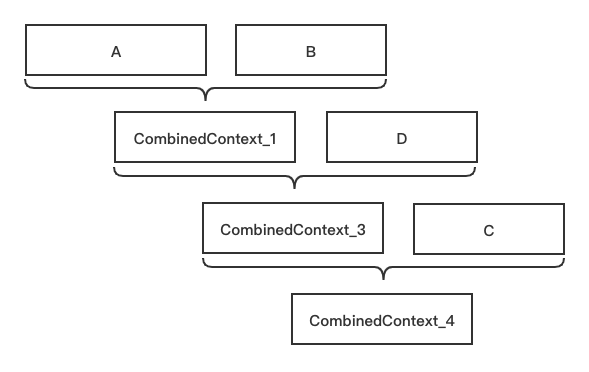
4пјүеҠ дёҠA
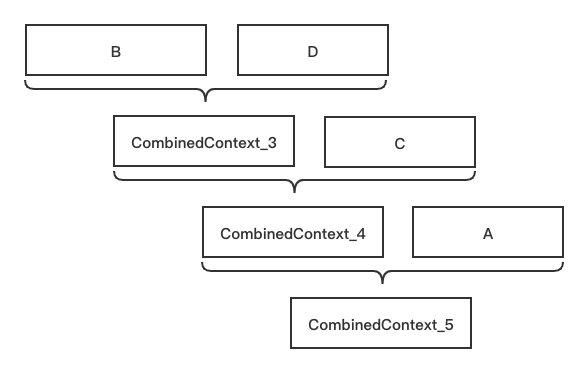
2.дёәд»Җд№ҲиҰҒе°ҶContinuationInterceptorж”ҫеҲ°еҚҸзЁӢдёҠдёӢж–Үзҡ„жңҖеҸіз«Ҝпјҹ
еңЁеҚҸзЁӢдёӯжңүеӨ§йҮҸзҡ„еңәжҷҜйңҖиҰҒиҺ·еҸ–ContinuationInterceptorгҖӮж №жҚ®д№ӢеүҚеҲҶжһҗзҡ„CombinedContextзҡ„minusKeyж–№жі•пјҢContinuationInterceptorж”ҫеңЁдёҠдёӢж–Үзҡ„жңҖеҸіз«ҜпјҢеҸҜд»ҘзӣҙжҺҘиҺ·еҸ–пјҢдёҚйңҖиҰҒз»ҸиҝҮеӨҡж¬Ўзҡ„еҫӘзҺҜгҖӮ
AbstractCoroutineContextElementе®һзҺ°дәҶElementжҺҘеҸЈпјҢе°ҶKeyеҜ№иұЎдҪңдёәжһ„йҖ ж–№жі•еҝ…иҰҒзҡ„еҸӮж•°гҖӮ
public abstract class AbstractCoroutineContextElement(public override val key: Key<*>) : Element
AbstractCoroutineContextKeyз”ЁдәҺе®һзҺ°Elementзҡ„еӨҡжҖҒгҖӮд»Җд№ҲжҳҜElementзҡ„еӨҡжҖҒе‘ўпјҹеҒҮи®ҫзұ»Aе®һзҺ°дәҶElementжҺҘеҸЈпјҢKeyдёәAгҖӮзұ»B继жүҝиҮӘзұ»AпјҢKeyдёәBгҖӮиҝҷж—¶е°Ҷзұ»Bзҡ„еҜ№иұЎж·»еҠ еҲ°дёҠдёӢж–ҮдёӯпјҢйҖҡиҝҮжҢҮе®ҡдёҚеҗҢзҡ„Key(AжҲ–B)пјҢеҸҜд»Ҙеҫ—еҲ°дёҚеҗҢзұ»еһӢеҜ№иұЎгҖӮе…·дҪ“д»Јз ҒеҰӮдёӢпјҡ
// baseKeyдёәиЎҚз”ҹзұ»зҡ„еҹәзұ»зҡ„Key
// safeCastз”ЁдәҺеҜ№еҹәзұ»иҝӣиЎҢиҪ¬жҚў
// Bдёәеҹәзұ»пјҢEдёәиЎҚз”ҹзұ»
public abstract class AbstractCoroutineContextKey<B : Element, E : B>(
baseKey: Key<B>,
private val safeCast: (element: Element) -> E?
) : Key<E> {
// йЎ¶зҪ®KeyпјҢеҰӮжһңbaseKeyжҳҜAbstractCoroutineContextKeyпјҢеҲҷиҺ·еҸ–baseKeyзҡ„йЎ¶зҪ®Key
private val topmostKey: Key<*> = if (baseKey is AbstractCoroutineContextKey<*, *>) baseKey.topmostKey else baseKey
// з”ЁдәҺзұ»еһӢиҪ¬жҚў
internal fun tryCast(element: Element): E? = safeCast(element)
// з”ЁдәҺеҲӨж–ӯеҪ“еүҚkeyжҳҜеҗҰжҳҜжҢҮе®ҡkeyзҡ„еӯҗkey
// йҖ»иҫ‘дёәдёҺеҪ“еүҚkeyзӣёеҗҢпјҢжҲ–иҖ…дёҺеҪ“еүҚkeyзҡ„йЎ¶зҪ®keyзӣёеҗҢ
internal fun isSubKey(key: Key<*>): Boolean = key === this || topmostKey === key
}getPolymorphicElementж–№жі•дёҺminusPolymorphicKeyж–№жі•
еҰӮжһңиЎҚз”ҹзұ»дҪҝз”ЁдәҶAbstractCoroutineContextKeyпјҢйӮЈд№Ҳеҹәзұ»еңЁе®һзҺ°ElementжҺҘеҸЈдёӯзҡ„getж–№жі•ж—¶пјҢе°ұйңҖиҰҒйҖҡиҝҮgetPolymorphicElementж–№жі•пјҢе®һзҺ°minusKeyж–№жі•ж—¶пјҢе°ұйңҖиҰҒйҖҡиҝҮminusPolymorphicKeyж–№жі•пјҢд»Јз ҒеҰӮдёӢпјҡ
public fun <E : Element> Element.getPolymorphicElement(key: Key<E>): E? {
// еҰӮжһңkeyжҳҜAbstractCoroutineContextKey
if (key is AbstractCoroutineContextKey<*, *>) {
// еҰӮжһңkeyжҳҜеҪ“еүҚkeyзҡ„еӯҗkeyпјҢеҲҷеҹәзұ»ејәеҲ¶иҪ¬жҚўжҲҗиЎҚз”ҹзұ»пјҢ并иҝ”еӣһ
@Suppress("UNCHECKED_CAST")
return if (key.isSubKey(this.key)) key.tryCast(this) as? E else null
}
// еҰӮжһңkeyдёҚжҳҜAbstractCoroutineContextKey
// еҰӮжһңkeyзӣёзӯүпјҢеҲҷејәеҲ¶иҪ¬жҚўпјҢ并иҝ”еӣһ
@Suppress("UNCHECKED_CAST")
return if (this.key === key) this as E else null
}public fun Element.minusPolymorphicKey(key: Key<*>): CoroutineContext {
// еҰӮжһңkeyжҳҜAbstractCoroutineContextKey
if (key is AbstractCoroutineContextKey<*, *>) {
// еҰӮжһңkeyжҳҜеҪ“еүҚkeyзҡ„еӯҗkeyпјҢеҹәзұ»ејәеҲ¶иҪ¬жҚўеҗҺдёҚдёәз©әпјҢиҜҙжҳҺеҪ“еүҚElementйңҖиҰҒеҺ»жҺүпјҢеӣ жӯӨиҝ”еӣһз©әдёҠдёӢж–ҮпјҢеҗҰеҲҷиҝ”еӣһиҮӘиә«
return if (key.isSubKey(this.key) && key.tryCast(this) != null) EmptyCoroutineContext else this
}
// еҰӮжһңkeyдёҚжҳҜAbstractCoroutineContextKey
// еҰӮжһңkeyзӣёзӯүпјҢиҜҙжҳҺеҪ“еүҚElementйңҖиҰҒеҺ»жҺүпјҢеӣ жӯӨиҝ”еӣһз©әдёҠдёӢж–ҮпјҢеҗҰеҲҷиҝ”еӣһиҮӘиә«
return if (this.key === key) EmptyCoroutineContext else this
}д»ҘдёҠе°ұжҳҜе…ідәҺвҖңKotlinеҚҸзЁӢдёҠдёӢж–ҮдёҺдёҠдёӢж–Үе…ғзҙ е®һдҫӢеҲҶжһҗвҖқиҝҷзҜҮж–Үз« зҡ„еҶ…е®№пјҢзӣёдҝЎеӨ§е®¶йғҪжңүдәҶдёҖе®ҡзҡ„дәҶи§ЈпјҢеёҢжңӣе°Ҹзј–еҲҶдә«зҡ„еҶ…е®№еҜ№еӨ§е®¶жңүеё®еҠ©пјҢиӢҘжғідәҶи§ЈжӣҙеӨҡзӣёе…ізҡ„зҹҘиҜҶеҶ…е®№пјҢиҜ·е…іжіЁдәҝйҖҹдә‘иЎҢдёҡиө„и®Ҝйў‘йҒ“гҖӮ
е…ҚиҙЈеЈ°жҳҺпјҡжң¬з«ҷеҸ‘еёғзҡ„еҶ…е®№пјҲеӣҫзүҮгҖҒи§Ҷйў‘е’Ңж–Үеӯ—пјүд»ҘеҺҹеҲӣгҖҒиҪ¬иҪҪе’ҢеҲҶдә«дёәдё»пјҢж–Үз« и§ӮзӮ№дёҚд»ЈиЎЁжң¬зҪ‘з«ҷз«ӢеңәпјҢеҰӮжһңж¶үеҸҠдҫөжқғиҜ·иҒ”зі»з«ҷй•ҝйӮ®з®ұпјҡis@yisu.comиҝӣиЎҢдёҫжҠҘпјҢ并жҸҗдҫӣзӣёе…іиҜҒжҚ®пјҢдёҖз»ҸжҹҘе®һпјҢе°Ҷз«ӢеҲ»еҲ йҷӨж¶үе«ҢдҫөжқғеҶ…е®№гҖӮ
жӮЁеҘҪпјҢзҷ»еҪ•еҗҺжүҚиғҪдёӢи®ўеҚ•е“ҰпјҒ